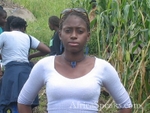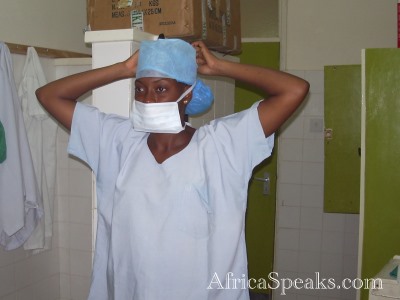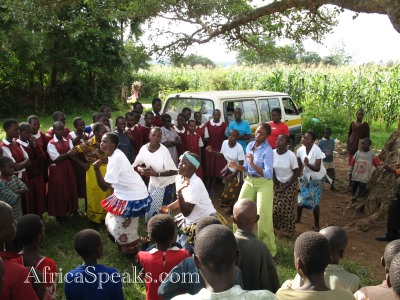The original URL of this article is:
www.africaspeaks.com/kenya/21082006.html
My Sojourn in Kenya
 | | | Renee Alfred | |
An account of the trip to
Bungoma and Kakamega, Kenya
by Renee Alfred
of the faculty of Medical Sciences,
the University of the West Indies
August 21, 2006
UWI Students Trip to Kenya
INTRODUCTION
On the eight day of June in the year two thousand and six, eighteen students representing the University of the West Indies, St. Augustine journeyed for three days to the African continent. More specifically, these students traveled to the western, rural districts of easterly situated Kenya.
The purposes for this trip, facilitated by the Kenyan Volunteer Development Services (KVDS), were numerous. They are as follows:
- To lend voluntary aid in the agro-forestation projects initiated by the KVDS and gain a better understanding and appreciation for agro-forestry issues in those districts.
- To lend voluntary aid and take part in community outreach projects in the districts of Bungoma and Kakamega.
- To research certain topics as outlined in the academic scheme for this trip and upon return submitting a report based on one's findings.
- To establish a viable link, starting with an exchange of ideas, between our university and a suited learning institution in Kenya so as to expand the territory of both universities for the benefit of the students at both institutions.
- To lend to the overall development of students of the University of the West Indies by exposing them to different cultures and thus broadening their scope of the world and positively enhancing their all-round education.
This excursion lasted twenty-eight days and involved students who were truly a representation of the university as every faculty was represented. Special emphasis was placed on the faculty of Natural Science and Agriculture due to the heavy agro-forestry nature of the trip. The faculty were represented by a total of six students while most other faculties had three to four representatives.
However, to ensure that all students were amply prepared, they all took part in a three day and night training camp on a farm in Cumuto, Trinidad. They slept in tents and carefully rationed food and water along with helping the farmer in his work, while at the same time undergoing training. They were taught the process of land and plant preparation and planting and reaping of crops, particularly corn and ground provisions.
It should be noted at this point that in keeping with the objectives of this trip, this report is partially ethnographic in nature and the information used here was acquired from analytic observation, interviews and documents prepared by official, recognizable organizations which are endorsed by the Kenyan Ministry of Health.
 | | Renee prepping in Kenyan Hospital |
An account of the mission to Bungoma, Kenya
WEEK ONE
June 8th – Tobago to London
June 9th – London to Dubai
June 10th – Dubai to Nairobi
June 11th – Nairobi to Bungoma
June 12th – Bungoma Town
June 13th – Uganda
June 14th – Webuye District Hospital and the Sio Primary School
June 15th – Lunao Primary School and the Sunrise Accademy
The first week was spent getting acquainted with our surroundings and starting our community outreach by visiting a few schools. During this time we were all awed by just being in Africa. Seeing the breathtaking sites- The Great Rift Valley, the landscape spotted by numerous mud houses, mothers with babies strapped to their backs, shoe polishers, unfathomable mountains, herds of zebras and families of baboons.
This week was also a period of adjustment for us. Adjustment to the climate, at twenty-seven degrees celsius and adjustment to the reserved culture of the people, particularly the women. The greatest adjustment however was that to food. This new taste caused many of us to have bouts of vomiting and diarrhoea that kept us all up in the wee hours of the morning either victims of this involuntary expulsion or charted for clean up.
On the trip to the border of Uganda and Kenya the culture change between the both people was particularly striking as the Ugandans seemed more extroverts.
The medical students also started our research into Kenya's Health system by conducting interviews and being onlookers in a few surgical procedures- two tumor removals, one from a young child's shoulder and the other on the right side of a boy's face protruding into his mandible. This latter procedure involved a tracheotomy. This all took place at the Webuye Public Hospital under the guidance Dr. Muhammad and some interviews were conducted at a private clinic and pharmacy owned by him.
While the medical students were at the hospital, the rest of the U.W.I team went to Sio Primary School. When the entire group met up with each other the remaining delegates expressed the fact that they were impressed by the level of intelligence of the students at this school and they were even more impressed by the cultural aspect that they presented. They were not too shy to join in themselves. The delegation also gave a short presentation on the culture of Trinidad and Tobago to the students.
Within this week we also did some work in agro-forestry when we visited an agricultural site run by the Kenyan Volunteer Development Services (KVDS). The KVDS is carrying out a re-forestation project there and the two farmers/caretakers living on the land taught us the different names for the trees and the advantages and disadvantages of growing them in between food crops. We were also taught about the trees mainly used in the project and the reasons for this. We even discovered a tree whose fruit was said to be proven to cure gonorrhea, typhoid and thirty-eight different diseases. The tree was called Neem.
We also took part in a tree planting ceremony at one school and we were entertained by the students. One particular boy at this school is most memorable in my mind. He played an indigenous instrument called the herp and he had a very unique and peculiar voice. I couldn't help but join in the traditional dances put on by the children. This was particularly interesting and enjoyable for me given my background in the arts and African dance.
 | | A sensational Saturday evening, Bungoma Village |
WEEK TWO
June 16th – Mount Elgon
June 18th – Cultural Exchange and Church
June 19th – Kakamega - Informative Presentation on Western University College of Science and Technology by Professor Toili
June 20th - Kenyan Volunteer Development Services' Resource Centre
June 21st - Medical Superintendent Kakamega District
June 22nd -Kenyan Volunteer Development Services' Resource Centre
This week the delegation made efforts to contact loved ones at home via the internet and a calling centre in Bungoma Town before leaving for Mount Elgon. When we got there however we were disappointed by the fact that a high ranking official had seen us in close proximity to the national park and advised guards at the gate to charge us the full cost in US and not the student price. Unfortunately, this cost was too high for most of us in the delegation. As compensation, the drive to the park which was about two hours long gave us a chance to see some more landscape and some zebras, bison and a strange type of deer that we couldn't identify.
This week we had our first official cultural exchange. We also staged a football match against some young villagers. Unfortunately for us, the local team won, but we weren't too crushed as the entire day's activities was enjoyed by all.
The executive director of the Kenyan Volunteer Development Services, Mr. Alwanga Malaho is actually a pastor of the Pentecostal church and on Sunday of this week we attended the church where he preaches. At this service, a member of the delegation, Miss Kimberly Gay, delivered the sermon and I rendered a religious song. The service was extremely vibrant and though the congregationers sang in Swahili there was not much difference in the way either party worshipped. After the service we started our journey to Kakamega. Now, what was funny about this is that we were told that Kakamega was not so far away. But for me, living on a one hundred and sixteen square foot island, that two hour drive was a little more than I catered for. I fell asleep on the way.
Once again the medical students had yet another chance to conduct interviews and collect information when we visited the District Medical Health Office, Kakamega district. We interviewed the Deputy District Public Health Officer. We learnt about the health system in the Kakamega district, the challenges faced overall and the factors that have attributed to these challenges.
A professor from the Western University College of Science and Technology, William Toili also paid us a visit in this week. This university college is young and is a constituent college of Moi University. He gave us a lecture about the university and the courses they offered as well as opportunities for a linkage between his university and ours. He also gave us an overview of the education system in Kenya and the opportunities Kenyans have to acquire tertiary education. He explained to us that there are only seven public universities serving the entire population of Kenya which stands at approximately thirty three million. Approximately sixty-eight thousand persons qualify for university but only ten thousand spaces are available. I suspect this is a contributing factor to Kenyan's brain drain problem.
This week was also carded to be the start of manual work as far as the agro-forestry aspect of the mission was concerned. This was kicked off with an official launching at the KVDS' Resource Centre in Kakamega. We were ushered into the village with a procession of drums and singing by villagers. This was actually the home town of Mr. Malaho and the center was actually on the land where he grew up. His parents' house was actually still standing. At the centre there was a tree nursery as well as land being utilized in a re-forestation and agriculture project. The organization also carries out several training courses and seminars for farmers and runs a small school.
In order to get the work done more effectively and to ensure that everyone had a chance to learn the technique of doing the required jobs, groups were formed that would rotate their functions everyday for the week. This discouraged specialization and allowed for equality. The groups planted eucalyptus seedlings, built a mud hut and planted indigenous trees.
We were also able to arrange an interview with the very busy medical superintendent of the district, Dr. Oyango so that he could give us (medical students) his view of the strengths and weaknesses of the health system as pertains to the district. He also gave his take on the fight against HIV/AIDS and infectious diseases in Kakamega. We were also given a chance to tour the district hospital and we were guided through the route that an HIV patient would take before receiving treatment with antiretroviral drugs. This individual would first go through a pre-counseling session before testing to prepare them for the outcome of the tests. After the ELISA and Unigold tests have been carried out post-counseling is done, then admission to the Comprehensive Care Centre (C.C.C). The services offered at the centre are free and include further tests and antiretroviral drug therapy. It must be noted that only if a CD4 test reveals that the white blood cell count is at two hundred and lower then drug therapy commences. If values are lower than three hundred and fifty then the patient will be monitored for opportunistic infections. Within the last two years the number has risen from forty-five thousand persons in Kenya receiving drug therapy to ninety-thousand persons.
Continue to Week Three and Week Four
UWI Students Trip to Kenya in pictures:
http://rastafarispeaks.com/gallery/Trip_to_Africa_2006
|
|